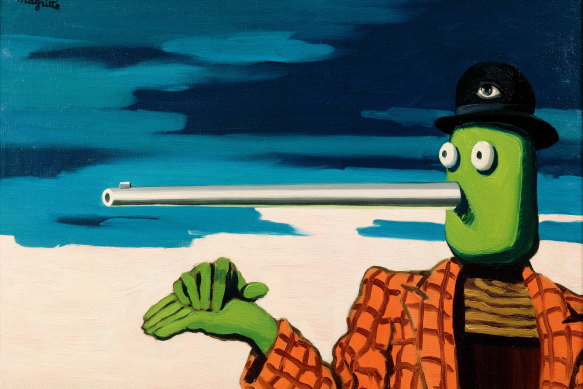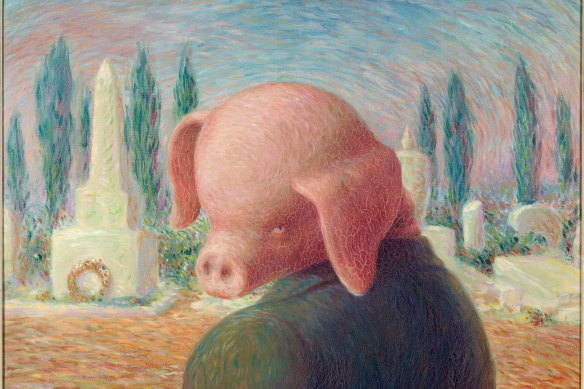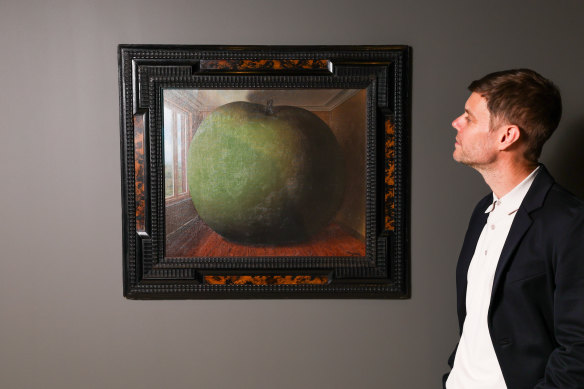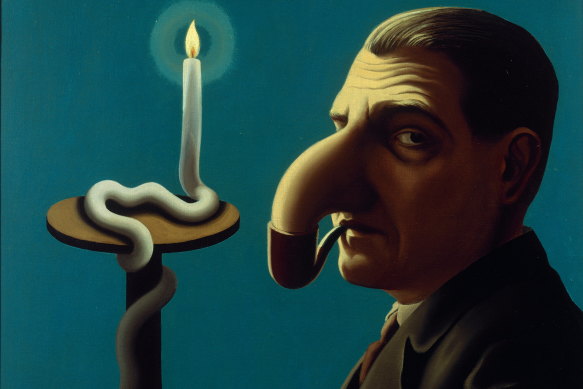This was published 8 months ago
Magritte’s sheer visual magic on show in AGNSW’s summer exhibition
By Joanna Mendelssohn
René Magritte was so successful in making images that confuse the mind that his art is embedded in popular culture. His outsized apples, cloudy skies and ubiquitous men in bowler hats are instantly recognised. When reproductions of an artist’s work become so familiar, how much can we learn from the real thing? With Magritte as the Art Gallery of NSW’s summer exhibition, the answer is: a great deal.
Despite his international fame and universal appeal, Magritte was, in essence, a provincial artist grounded in the culture and sensibility of Belgium and connected to a close circle of friends. The young artist’s education at Brussels’ Académie des Beaux-Arts directed him towards a career in illustration. It is no accident that the most successful of his early works was Cinema Bleu. While influenced by the art deco graphics of the advertising commissions that were his bread and butter, the painting shows elements that would also be present in his mature work. The composition is framed with curtains while a hot air balloon crosses the sky.

René Magritte with the iconic bowler hat.Credit:
The main source of ideas for the young artist was to be found in Parisian art magazines. For those in the provinces, real life is always elsewhere. Magritte made a stab at painting in a cubist style, but a black-and-white reproduction of Giorgio de Chirico’s The Song of Love freed him from worrying about new painting techniques. He realised he could focus on content, painting disturbing subjects in a deadpan, academic style. He once said that what is hidden can “take the form of a quite intense feeling, a sort of conflict, one might say, between the visible that is hidden and the visible that is apparent”.
This is evident in the muted tones of The Garment of Adventure, shown in his first solo exhibition in 1927. A mysterious, passive, veiled woman reaches out to a floating leatherback turtle that may help her float away to another dimension. Magritte’s mother drowned by suicide when he was 13. It has been suggested that this painting, with echoes of the drowned Ophelia in Shakespeare’s Hamlet, is a reference to his ongoing grief at her loss.

René Magritte’s The ellipsis (L’ellipse), 1948.Credit:
An unkind reviewer of this first exhibition claimed his art was “cultivated for its unreality and strangeness”, but his dealer had sufficient faith in him to pay a small allowance that enabled the artist to move to Paris. Here, he came to know the artists and poets of the avant-garde surrealist movement, led by André Breton, but ever the provincial, Magritte and his wife Georgette lived in an outer suburb. Nevertheless, these Parisian years were among his most productive. He contributed to the journal La Revolution surrealiste, and his paintings were collected by members of the group, including Breton.
The most intriguing work from Magritte’s Paris years is The Eternally Obvious, a full-length nude study of Georgette comprising a series of small paintings of different sections of her body but mounted so that there is space between each image, visually confusing the viewer’s eye. Magritte had planned to hold a solo exhibition in Paris, but the financial collapse of 1929 ended that hope, and he returned to Brussels, where his skills as a commercial artist and money from Georgette’s father kept them in frugal comfort.

Magritte’s A Stroke of Luck (La bonne fortune), 1945.Credit:
In 1933, US photographer Man Ray sold Magritte’s The False Mirror to New York’s Museum of Modern Art. The painting of a giant eye filled with a cloudy sky was included in MoMA’s groundbreaking 1936 exhibition Fantastic Art, Dada, Surrealism.
AGNSW exhibition curator Nicholas Chambers has grouped works made soon after Magritte’s return to Belgium as The Philosophical Lamp, the name of one of the paintings from this period. It shows a man with his nose growing into his pipe, illuminated by a candle with a sinuously curving base. The word games of the Parisian surrealists now became less important to him than visualising ambiguity.
This is the period of his most delightful This Is a Piece of Cheese, a full-size painting of a slice of brie enclosed in an actual glass cheese dome. A painting, In Praise of Dialectics, shows a window opening into a room that contains the house. Ideas do not need words to communicate.

Exhibition curator Nicholas Chambers.Credit: Edwina Pickles
With the rise of the Nazis in Germany, there was a mass emigration of artists and writers to the safety of the US. Magritte was unusual in that he stayed in Belgium for the duration of World War II, enduring the deprivations of occupation. He found that empty wine bottles made an excellent surface for paintings. As money was scarce, he used his skills as an artist to paint forgeries of old masters, which he sold to the Nazi occupiers. One of these, a “Titian”, shows his skill in impersonating other styles. Later, he also forged banknotes.
As a counter to the grief of the war, Magritte consciously lifted his palette and loosened his style. His approximation of impressionism led to what is called his “Renoir period”, but his subject matter was less innocent. In A Stroke of Luck, a pig in a cemetery looks smugly at the viewer, satisfied that he is not the one in the grave.

The Philosophical Lamp (La lampe philosophique), 1936.Credit:
The Belgian artists who exhibited what Magritte called “Surrealism in full sunlight” after the war ended were condemned by Breton, who subsequently excluded Magritte from the major International Surrealist Exhibition of 1947. Magritte’s next exhibition, his first solo exhibition in Paris, fared even worse. These were his vache (mean) paintings. Their deliberately rough technique and intense colours have little in common with any of his other art.
If he had continued to paint works like The Ellipsis with its loosely painted green head and gun barrel nose, Magritte might have evolved into one of the more interesting postwar European artists. But both his New York dealer and his wife asked him to return to his earlier whimsical style, which collectors were clamouring for, and the art market gave them financial security.
While there is some repetition in his later work, there are also paintings that are sheer visual magic. The Dominion of Light (1954) teases the viewer with a sunny sky presiding over a nocturne. Ambiguity reigns and nothing is as it seems.
Magritte is at the Art Gallery of New South Wales until February 9.